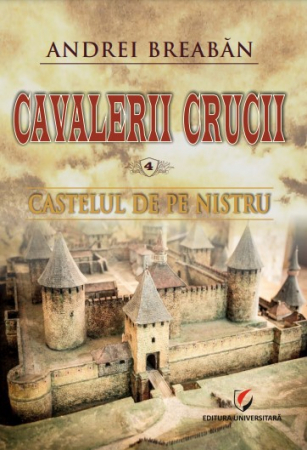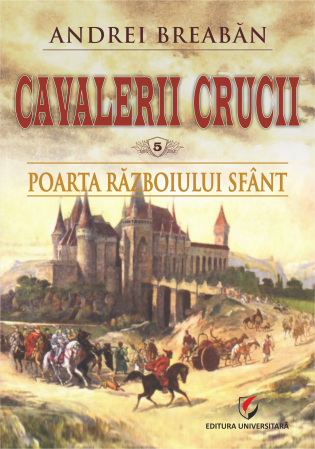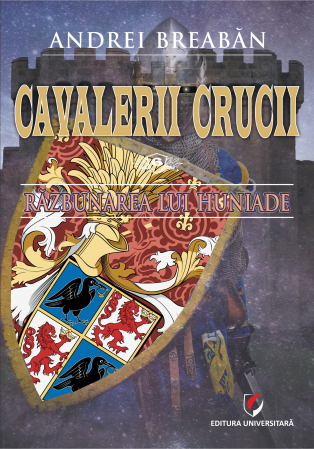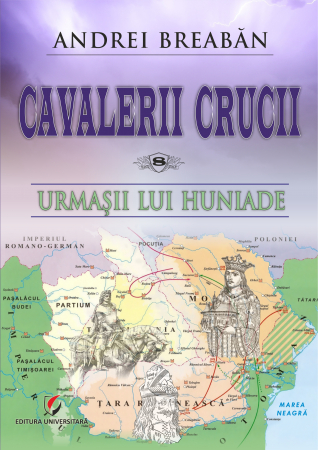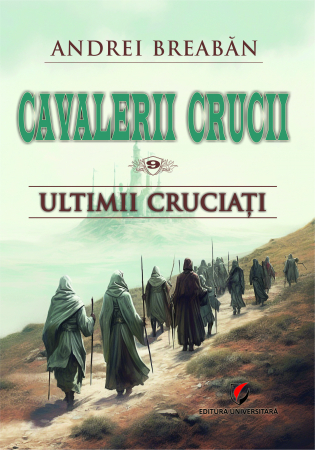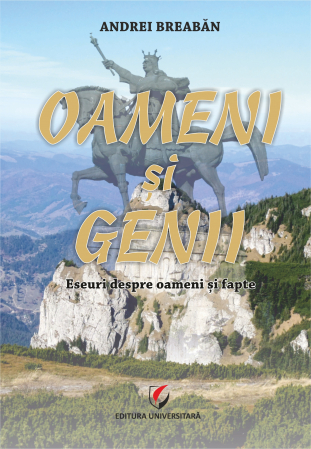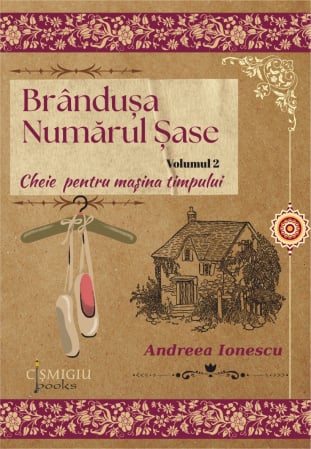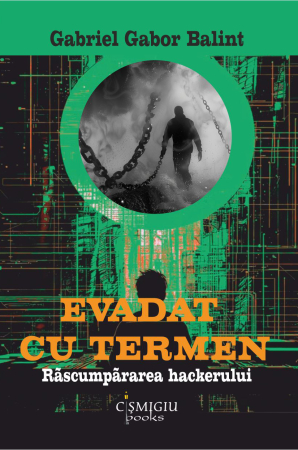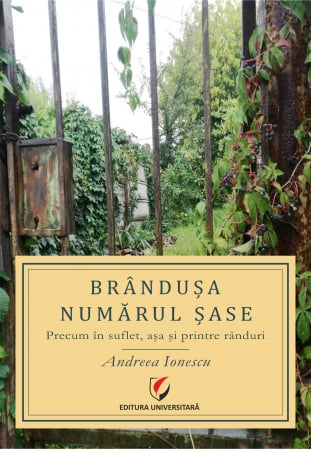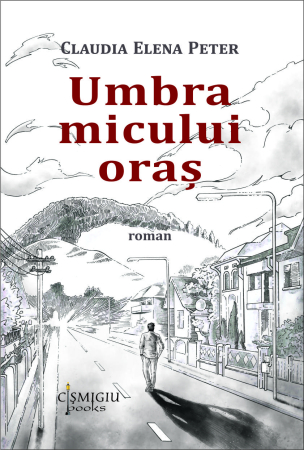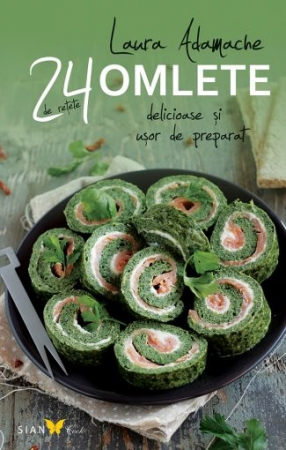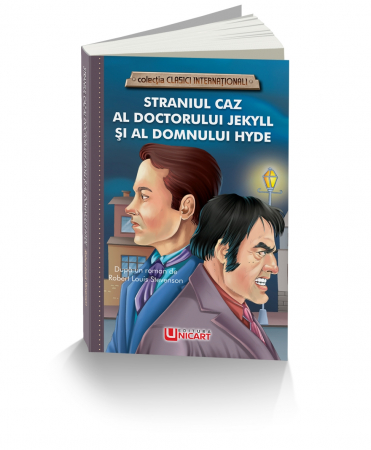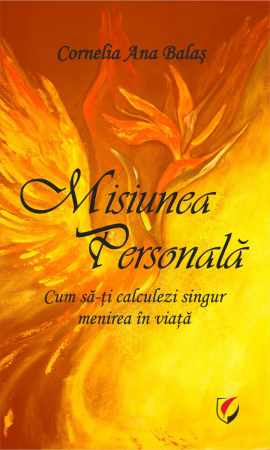ORDERS RECEIVED IN THE PERIOD 19.12.2025 - 07.01.2026 WILL BE FULFILLED STARTING ON 08.01.2026
Publisher: Editura Universitară
Author: Andrei Breaban
Edition: I
Pages: 370
Publisher year: 2024
ISBN: 978-606-28-1768-8
DOI: 10.5682/9786062817688
Product Code:
9786062817688
Do you need help?
0745 200 357
- Description
- Download (1)
- Authors
- Content
- More details
- Reviews (0)
Writing a historical novel, especially today, means taking a major risk. Even more so when you choose to venture into such a theme as this one in the present novel. Elaborating a literary fiction about the life of Stephen the Great and Saint is not at all easy, especially since there are immortal pages by Sadoveanu and Iorga in this regard. It is all the more appreciated the way in which the author found the way to move away, intelligently, from the huge models mentioned above, delimiting and feeding an extremely generous imaginary space, precisely through ignorance.
And the absence of unnecessary digressions proves that Andrei Breabăn learned, in a salutary complementarity, the lesson of history and the lesson of literary fiction, melting them into an original matter, similar to that from which chivalric novels started, once, then their replicas started by Walter Scott, Sienkiewicz, Sadoveanu, later, when these great authors understood to reimagine, in contexts of great artistic originality, stories that have always charmed. It is precisely for this reason (as well as for many other reasons) that we welcome this editorial appearance with interest, wishing it its due success.
Constantin Dram, ”A different kind of historical novel”, published in ”Rotonda Valaha” magazine, Râmnicu Vâlcea no. 3 (26) of 2022
And the absence of unnecessary digressions proves that Andrei Breabăn learned, in a salutary complementarity, the lesson of history and the lesson of literary fiction, melting them into an original matter, similar to that from which chivalric novels started, once, then their replicas started by Walter Scott, Sienkiewicz, Sadoveanu, later, when these great authors understood to reimagine, in contexts of great artistic originality, stories that have always charmed. It is precisely for this reason (as well as for many other reasons) that we welcome this editorial appearance with interest, wishing it its due success.
Constantin Dram, ”A different kind of historical novel”, published in ”Rotonda Valaha” magazine, Râmnicu Vâlcea no. 3 (26) of 2022
-
Knights of the Cross - Volume 7. Valors of His Mary - Andrei Breaban
Download
ANDREI BREABAN
Preface - Athletes of Christianity - by Ioan Holban / 5
Chapter 1 – The light of the world went out / 9
Chapter 2 – Behind the scenes of the Imperial Palace / 42
Chapter 3 – At the Gate of Happiness / 61
Chapter 4 – Zaganos Pasha / 88
Chapter 5 – Back to Belgrade / 105
Chapter 6 – Stopover in Timișoara / 117
Chapter 7 – Secrets in the Huniaz Castle / 129
Chapter 8 – Council of the Country / 173
Chapter 9 – Nuremberg Diet / 194
Chapter 10 – Winter holidays in Târgoviște / 217
Chapter 11 – Epiphany / 253
Chapter 12 – His Majesty's Valors / 275
Chapter 13 – Voivodship Wedding / 294
Chapter 14 – The Logos Mihu / 302
Chapter 15 – Letter of adventures / 330
Glossary / 354
Bibliography / 361
Chapter 1 – The light of the world went out / 9
Chapter 2 – Behind the scenes of the Imperial Palace / 42
Chapter 3 – At the Gate of Happiness / 61
Chapter 4 – Zaganos Pasha / 88
Chapter 5 – Back to Belgrade / 105
Chapter 6 – Stopover in Timișoara / 117
Chapter 7 – Secrets in the Huniaz Castle / 129
Chapter 8 – Council of the Country / 173
Chapter 9 – Nuremberg Diet / 194
Chapter 10 – Winter holidays in Târgoviște / 217
Chapter 11 – Epiphany / 253
Chapter 12 – His Majesty's Valors / 275
Chapter 13 – Voivodship Wedding / 294
Chapter 14 – The Logos Mihu / 302
Chapter 15 – Letter of adventures / 330
Glossary / 354
Bibliography / 361
With the novel Knights of the Cross, Andrei Breabăn's Stefanian cycle, Valors of His Mary, reaches the "seventh book", as he says; it is a solid construction, singular in our prose today, with a wide breath, well articulated, each volume having its links of continuity in the narrative chain, of the Romanian series, but also innovating every time, because, here, Andrei Breabăn knows well to make moving portraits of the historical characters and, equally, of the anonymous ones of the era, to lead the narrative thread and, above all, to evoke the battle scenes in a cinematic sequence of images. The Knights of the Cross begins with the year 1456, when Iancu de Hunedoara, "the last hope of the followers of Christ, the defender of Christianity, the one who kept alive the flame of the anti-Ottoman struggle all his life, making vain efforts to gather together the Christian kingdoms of that time" died, assassinated ". Andrei Breabăn skilfully uses, in his novel, the semantics of the term crusader: of the fighter in the historical crusades for the (re)conquest of the Holy Sepulcher, but he transfers the meaning to the defenders of the Cross, Iancu de Hunedoara, Vlad Țepeș and Ştefan the Great and the Holy: these are the last crusaders of Christianity. "Iancu de Hunedoara, Vlad Țepeş and Stefan the Great will be the only princes of Christian Europe who will face and defeat Mohammed II, the conqueror of Constantinople. The three were and will remain in history the last crusaders of Christianity", writes the prose writer clearly. And the truth is spoken, from yesterday, for today, by the Cadi of Mohammed himself, who says: "I don't know what sins they have to pay for, but these Wallachians are a strange race. You can't find two who understand each other. And when it comes to power, brother kills brother to take the throne".
A long line of reconstructions, descriptions, portraits constitute the charm of Andrei Breabăn's book; Knights of the Cross is a history book, but, first of all, a novel, where the author's imagination works at high tension, but well-tempered, controlled by extensive documentation and an impressive bibliography: how Muhammad transforms Constantinople ("Taking into control of Constantinople, Mohammed II enters triumphantly, followed by viziers and army commanders into Saint Sophia, which he declares to be an Ottoman mosque, eight other Christian churches being transformed into mosques, besides which he built madrasahs. The Sultan sends his servants to find scholars from Persia, Egypt, and Turkestan to whom he gave large houses and lands to stay at his schools. Besides them, he brought students trained in the madrasahs of Bursa and Edirne. He then ordered the construction of an imposing bedestan where merchants could brings and stores the goods. Applying the imaret system in Istanbul as well, he will erect a building complex around the mosques consisting of madrasahs, hospitals, inns for travelers, bazaar, public bath, mill, boiangery, zahana, the indispensable canteen for the poor, all provided with water installations, roads and bridges, well set up") and a bathroom from that time ("On a large stove and always heated by the care of the servants who took care of the rooms, there was a tuci cauldron full of hot water, with some cold water in it. After putting the latch on the door, Maruşca takes off her hood and hood. He mixes the water with a large clay cup until it is sufficiently warm, after which it enters the crucible"), the organization of the Imperial Palace of Mahomed, the organization of Transylvania under the Arpadian kings of Hungary and the Scythian seats ("Organized according to military criteria, the Scythian seats they were headed by the hotnog of the seat, who was also the captain of the banderia of this land, he was helped by the seat jude, the royal jude and 12 elected sworn assessors. Together they formed the Szekler sedria. The 7 seats were led by a committee of the Szeklers appointed by the king from among to the great Hungarian nobles in Transylvania, often this being the voivode. In order to mobilize more easily, at the request of the Voivode or the king of Hungary, the villages were divided into decuries, organized according to military rules, the decuries formed belts and then larger units. The Szekler peasants were on foot, the cavalry being made up of nobles or owners of workshops from the cities that were led by a council made up of 12 jurors headed by the county or vilic, chosen every year from the towns of the vase"), the Huniazi castle, with the invocation of some legends ("Capestrano Tower it is adjacent to the Diet Hall in the Corvinor Castle, and access from the banquet hall is via a few steps that lead to the upper level, where the room in the tower is located. A legend says that one of John of Hunedoara's informants was hiding in a small secret room in the wall that separates the tower from the Diet Hall in Corvinilor Castle, who secretly observed what was happening in the hall in the absence of the master of Corvinilor Castle"), the ceremony of reception among the valors of His Majesty, with anthological pages that make the way from the imaginary to the document, naturally.
These documented descriptions from the era, but also coming from the prodigious imagination of the author, make up a fresco of the era, of the epochal time, irrigated from within by the core of the intrigue, with the attempt to exterminate the Huniaz race, Vlad Țepeş's fight with the boyars and the preparations of Ştefan the Eager to return to the throne of his father, killed in an assassination attempt, the battle scenes are often bloody: "One of the riders breaks away from the group and, after pretending to return to the Monastery, makes a detour through the forest and he rushes to the Piatra market where it is, the closest garrison of the Voivodeship of Moldavia. But he doesn't get far from the meeting place with the attackers when he is stopped by hussars who come out of the forest and surround him. Frightened, he takes his sword out of its sheath, trying to cut his way through those who surrounded him, but he has no chance. One of the hussars parries the sword blow while another sticks a spear in his back. Snorting, Costică leans back and falls from his horse like a sack of wheat pushed by a cold winter wind. The fresh, soft snow that has barely settled for a few days is crushed, letting the blood pour out of the wound that makes a large stain around the body lying between the trees in the forest. With the last gasps of life, Costică props himself up with his hand on his sword and tries to get up, but the blood continues to pour out of his chest, soaking his clothes. - Finish with him before he starts to scream, to hear him, his! shouted one of the hussars to the comrade who recovered his spear, pulling it hard from behind the fugitive. Heeding the advice, the hussar draws his sword from its scabbard, raises it above his head, then brings it down sharply on the fugitive's neck, splitting his head with one blow. After it detaches from the body, the head rolls down the valley, stopping in a stump, located about three steps away from the body. While the body was writhing in spasms, the wide-open eyes looked fearfully at those who split his head, as if they wanted to take them with them into the immortality they were heading towards".
"La qualité maîtresse" of Andrei Breabăn's prose is, without a doubt, the art of the portrait, whether it is Mohammed with his "bending" towards Christianity, a soldier from Stefan's army or Mrs. Oltea: the reconstruction is completely remarkable, it is, rather, a recall of the image from the past. Andrei Breabăn's Stefanian cycle not only (re)values, from the prose writer's point of view, some of the bright figures of our Middle Ages, valued, until now, one would think, only by the legends that still circulate in folklore and the clergy who immortalized him with the term "Saint", on July 2: Andrei Breabăn makes Ştefan the Great a credible novel character, but also our contemporary and "pays" a debt that Romanian prose writers have had since Mihail Sadoveanu.
Ioan Holban
A long line of reconstructions, descriptions, portraits constitute the charm of Andrei Breabăn's book; Knights of the Cross is a history book, but, first of all, a novel, where the author's imagination works at high tension, but well-tempered, controlled by extensive documentation and an impressive bibliography: how Muhammad transforms Constantinople ("Taking into control of Constantinople, Mohammed II enters triumphantly, followed by viziers and army commanders into Saint Sophia, which he declares to be an Ottoman mosque, eight other Christian churches being transformed into mosques, besides which he built madrasahs. The Sultan sends his servants to find scholars from Persia, Egypt, and Turkestan to whom he gave large houses and lands to stay at his schools. Besides them, he brought students trained in the madrasahs of Bursa and Edirne. He then ordered the construction of an imposing bedestan where merchants could brings and stores the goods. Applying the imaret system in Istanbul as well, he will erect a building complex around the mosques consisting of madrasahs, hospitals, inns for travelers, bazaar, public bath, mill, boiangery, zahana, the indispensable canteen for the poor, all provided with water installations, roads and bridges, well set up") and a bathroom from that time ("On a large stove and always heated by the care of the servants who took care of the rooms, there was a tuci cauldron full of hot water, with some cold water in it. After putting the latch on the door, Maruşca takes off her hood and hood. He mixes the water with a large clay cup until it is sufficiently warm, after which it enters the crucible"), the organization of the Imperial Palace of Mahomed, the organization of Transylvania under the Arpadian kings of Hungary and the Scythian seats ("Organized according to military criteria, the Scythian seats they were headed by the hotnog of the seat, who was also the captain of the banderia of this land, he was helped by the seat jude, the royal jude and 12 elected sworn assessors. Together they formed the Szekler sedria. The 7 seats were led by a committee of the Szeklers appointed by the king from among to the great Hungarian nobles in Transylvania, often this being the voivode. In order to mobilize more easily, at the request of the Voivode or the king of Hungary, the villages were divided into decuries, organized according to military rules, the decuries formed belts and then larger units. The Szekler peasants were on foot, the cavalry being made up of nobles or owners of workshops from the cities that were led by a council made up of 12 jurors headed by the county or vilic, chosen every year from the towns of the vase"), the Huniazi castle, with the invocation of some legends ("Capestrano Tower it is adjacent to the Diet Hall in the Corvinor Castle, and access from the banquet hall is via a few steps that lead to the upper level, where the room in the tower is located. A legend says that one of John of Hunedoara's informants was hiding in a small secret room in the wall that separates the tower from the Diet Hall in Corvinilor Castle, who secretly observed what was happening in the hall in the absence of the master of Corvinilor Castle"), the ceremony of reception among the valors of His Majesty, with anthological pages that make the way from the imaginary to the document, naturally.
These documented descriptions from the era, but also coming from the prodigious imagination of the author, make up a fresco of the era, of the epochal time, irrigated from within by the core of the intrigue, with the attempt to exterminate the Huniaz race, Vlad Țepeş's fight with the boyars and the preparations of Ştefan the Eager to return to the throne of his father, killed in an assassination attempt, the battle scenes are often bloody: "One of the riders breaks away from the group and, after pretending to return to the Monastery, makes a detour through the forest and he rushes to the Piatra market where it is, the closest garrison of the Voivodeship of Moldavia. But he doesn't get far from the meeting place with the attackers when he is stopped by hussars who come out of the forest and surround him. Frightened, he takes his sword out of its sheath, trying to cut his way through those who surrounded him, but he has no chance. One of the hussars parries the sword blow while another sticks a spear in his back. Snorting, Costică leans back and falls from his horse like a sack of wheat pushed by a cold winter wind. The fresh, soft snow that has barely settled for a few days is crushed, letting the blood pour out of the wound that makes a large stain around the body lying between the trees in the forest. With the last gasps of life, Costică props himself up with his hand on his sword and tries to get up, but the blood continues to pour out of his chest, soaking his clothes. - Finish with him before he starts to scream, to hear him, his! shouted one of the hussars to the comrade who recovered his spear, pulling it hard from behind the fugitive. Heeding the advice, the hussar draws his sword from its scabbard, raises it above his head, then brings it down sharply on the fugitive's neck, splitting his head with one blow. After it detaches from the body, the head rolls down the valley, stopping in a stump, located about three steps away from the body. While the body was writhing in spasms, the wide-open eyes looked fearfully at those who split his head, as if they wanted to take them with them into the immortality they were heading towards".
"La qualité maîtresse" of Andrei Breabăn's prose is, without a doubt, the art of the portrait, whether it is Mohammed with his "bending" towards Christianity, a soldier from Stefan's army or Mrs. Oltea: the reconstruction is completely remarkable, it is, rather, a recall of the image from the past. Andrei Breabăn's Stefanian cycle not only (re)values, from the prose writer's point of view, some of the bright figures of our Middle Ages, valued, until now, one would think, only by the legends that still circulate in folklore and the clergy who immortalized him with the term "Saint", on July 2: Andrei Breabăn makes Ştefan the Great a credible novel character, but also our contemporary and "pays" a debt that Romanian prose writers have had since Mihail Sadoveanu.
Ioan Holban
If you want to express your opinion about this product you can add a review.
write a review

6359.png)
![Knights of the Cross - Volume 7. Valors of His Mary - Andrei Breaban [1] Knights of the Cross - Volume 7. Valors of His Mary - Andrei Breaban [1]](https://gomagcdn.ro/domains/editurauniversitara.ro/files/product/large/cavalerii-crucii-volumul-7-vitejii-mariei-sale-andreai-breaban-165153.jpg)

